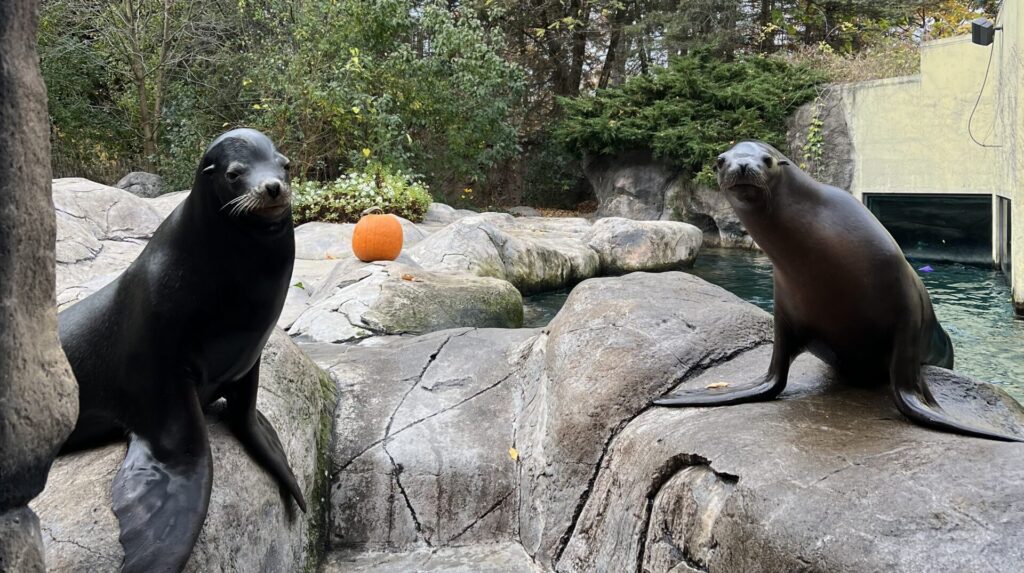Summary of Gunnison’s Travels: An update on our visiting sea lion:
Zoo Keeper Sue Rea writes this content and provides an update on Gunni, the sea lion who temporarily resides at the Seneca Park Zoo. Gunni, originally from Denver Zoo, moved to Seneca Park Zoo while his home zoo was constructing a new sea lion habitat. He has adjusted well to his new environment, engaging actively with other sea lions, participating in training, and enjoying a diet that includes 18 pounds of fish daily. Gunni is described as intelligent, eager to please, and possesses a sweet temperament that endeared him to the zoo staff and visitors.
– The importance of zoo exchange programs for animal welfare and conservation
– Details on Gunnison’s daily life and care at Seneca Park Zoo
– The role of dietary management in maintaining the health of sea lions
– The significance of training and enrichment in promoting mental and physical well-being
– Conservation efforts for sea lions and their natural habitats
Zoo exchange programs are pivotal in enhancing animal welfare, conservation efforts, and the genetic diversity necessary for the survival of many species. One shining example of such a program is the temporary relocation of Gunnison, a charismatic sea lion, from Denver Zoo to Seneca Park Zoo. Gunnison’s journey offers invaluable insights into the intricate care, behavioral training, and conservation strategies pivotal for the well-being of sea lions in zoo settings.
Gunnison, affectionately known as Gunni, has seamlessly integrated into his new environment at Seneca Park Zoo. Weighing 292 pounds, his days are spent engaging with fellow sea lions Hike, Mary Lou, Angel, and Daley. The remarkable cohesion among these animals highlights the zoo’s success in creating a supportive and stimulating environment for these marine mammals. Gunni’s seamless adjustment also underscores the importance of thorough planning and care in managing zoo animals, particularly when facility transitions are involved.
Dietary management plays a critical role in the health and happiness of sea lions. Gunni’s diet, comprising approximately 18 pounds of fish daily, including capelin, herring, mackerel, and squid, is meticulously balanced to meet his nutritional needs. Fish-filled ice blocks and feeder toys also serve a dual purpose: providing necessary nutrition and stimulating natural foraging behaviors. This nuanced approach to feeding underscores the zoo’s commitment to replicating natural behaviors and promoting physical well-being through diet.
Beyond physical health, mental stimulation and training are vital components of Gunnison’s care regimen. His eagerness to engage in training sessions facilitates essential veterinary care without stress and fortifies his bond with the zookeepers. These interactions are crucial for mental stimulation, reinforcing positive behaviors, and ensuring his well-being. Training exercises, crafted with clear objectives and positive reinforcement, exemplify the zoo’s dedication to fostering a nurturing and enriching environment for its inhabitants.
Conservation efforts extend beyond the individual care of animals like Gunnison. Like many marine species, sea lions face numerous threats in the wild, including habitat loss, pollution, and overfishing. Zoos play a critical role in conservation and education, raising awareness about these issues and supporting research and initiatives to protect these creatures and their habitats. Gunnison’s stay at Seneca Park Zoo catalyzes discussing broader conservation topics, engaging the public in meaningful dialogues about wildlife preservation.
Seneca Park Zoo ensures animals like Gunnison thrive through detailed and attentive management. This case exemplifies how zoos contribute to conservation efforts, provide exemplary care, and educate the public on protecting marine life. Gunnison’s story is a testament to the positive outcomes achievable when zoos prioritize the welfare of their animals, underscoring their role as modern arks for endangered species. Through Gunnison’s travels and the dedicated care he receives, the zoo not only nurtures its charges but also plays a crucial part in the broader canvas of wildlife conservation.


